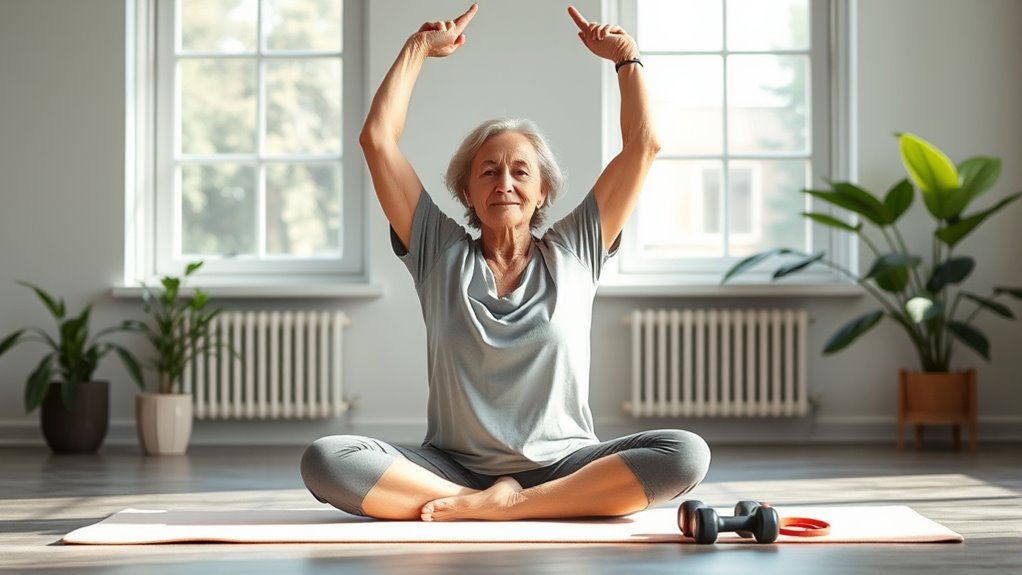Incorporate gentle exercises like mindful stretching, chair yoga, or slow, controlled movements into your routine to improve flexibility and strength safely. Focus on listening to your body, using deep breathing, and moving deliberately to avoid strain. These practices are accessible, require no special equipment, and can fit into even busy schedules. Keep exploring routines that suit your needs, and you’ll discover more ways to enhance your well-being gradually.
Key Takeaways
- Incorporate mindful stretching and slow movements to enhance flexibility safely.
- Practice chair yoga poses that target neck, shoulders, and legs for gentle strength building.
- Focus on controlled exercises that improve joint mobility and muscle tone without strain.
- Use deep breathing to relax muscles and increase the effectiveness of gentle stretches.
- Integrate short, regular sessions to support ongoing flexibility, strength, and overall well-being.

Have you ever wondered how to stay active without putting too much strain on your body? If so, gentle exercises might be perfect for you. They offer a way to boost your flexibility and strength while minimizing the risk of injury or discomfort. One effective approach is mindful stretching, which involves paying close attention to your body’s signals as you gently lengthen muscles and improve joint mobility. Instead of rushing through stretches, you focus on slow, deliberate movements and deep breathing, helping to relax tense muscles and increase your awareness of physical sensations. Mindful stretching is especially beneficial if you’re recovering from injury, managing chronic pain, or simply looking for a calming way to stay active.
Another excellent option is chair yoga, which adapts traditional yoga poses to be performed while seated or using a chair for support. This practice is accessible to people of all ages and fitness levels, including those with limited mobility or balance issues. When practicing chair yoga, you can incorporate gentle stretches that target your neck, shoulders, back, and legs, enhancing flexibility and reducing stiffness. Since it’s low-impact, chair yoga allows you to engage in movement without overtaxing your joints or muscles. Plus, it encourages mindfulness, helping you stay present and focused during each pose. You might find that these seated exercises improve your posture, relieve tension from long hours of sitting, and boost your overall sense of well-being.
Both mindful stretching and chair yoga emphasize controlled, deliberate movements, making them safe yet effective ways to incorporate physical activity into your routine. They work well when you’re short on time or feeling fatigued but still want to maintain your strength and flexibility. You don’t need special equipment or a gym membership—just a comfortable space and a willingness to listen to your body. As you practice regularly, you’ll likely notice improved range of motion, reduced muscle tightness, and a greater sense of calm. These gentle exercises can become a calming ritual, helping you manage stress while supporting your physical health.
Gentle, mindful movements boost flexibility, reduce stress, and fit easily into any routine.
Incorporating mindful stretching and chair yoga into your daily routine is straightforward. Start with a few minutes each day, focusing on slow, controlled movements and mindful breathing. Over time, you’ll build strength and flexibility without pushing yourself into discomfort. Whether you’re dealing with age-related stiffness, recovering from an injury, or simply seeking a gentle way to stay active, these exercises can be an essential part of your wellness journey. They prove that you don’t need intense workouts to make meaningful progress—gentle, mindful movements are enough to improve your overall health and vitality. Additionally, these practices foster a growth mindset that encourages continuous improvement and adaptation to your body’s changing needs.
Frequently Asked Questions
Can These Exercises Help With Chronic Back Pain?
You might wonder if gentle exercises can help with chronic back pain. The good news is, they can promote back pain relief when done safely. These exercises improve flexibility and strengthen muscles, supporting your spine. Always prioritize exercise safety by starting slowly and listening to your body. Consult a healthcare professional before beginning any new routine to confirm it’s right for your condition. Consistent gentle movement can make a noticeable difference in managing chronic back pain.
How Often Should I Perform These Exercises Weekly?
You should aim for an exercise frequency of about three to five times a week to see benefits without overdoing it. An ideal workout schedule includes gentle exercises that improve flexibility and strength, allowing your muscles to recover between sessions. Stick to a consistent routine, and listen to your body—if you feel sore or fatigued, take a rest day. This balanced approach helps maximize progress and minimizes injury risk.
Are There Any Age Restrictions for These Exercises?
You might wonder about age considerations for these exercises. Generally, they’re safe for most ages, but it’s important to take into account individual health and fitness levels. Always follow safety precautions, especially if you have pre-existing conditions or mobility issues. Consult your healthcare provider if you’re unsure. Adjust exercises as needed, and start slowly to avoid injury. Staying mindful of your body’s signals helps ensure safe, effective practice regardless of age.
Do These Exercises Require Any Special Equipment?
Oh, do you need fancy equipment for these exercises? Not at all! Just grab a resistance band if you want a little extra challenge, or a yoga mat to stay comfy and prevent slips. No professional gym membership required — your living room or backyard works perfectly. These exercises are designed to be simple and accessible, so you can start anytime without hunting down fancy gear. Easy peasy!
Can Beginners Safely Do These Exercises at Home?
You can definitely do these exercises safely at home as a beginner. Focus on proper form and start slowly to guarantee safety. Use home adaptations like a sturdy chair or mat for support. Remember, beginner safety is key; listen to your body and avoid pushing too hard. With patience and consistency, you’ll improve flexibility and strength comfortably at home, making it a convenient and effective way to stay active.
Conclusion
Incorporating gentle exercises into your routine is like tending to a delicate garden—you nurture your flexibility and strength with patience and care. These movements are easy to do and perfect for maintaining your health without strain. Remember, consistency is key; even small efforts add up over time. So, take a deep breath, stay gentle with yourself, and enjoy the calming, strengthening benefits of these exercises. Your body will thank you for it!









